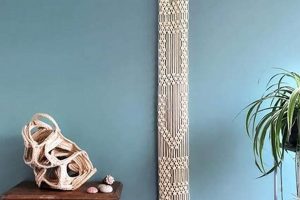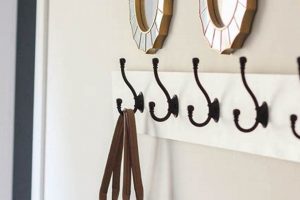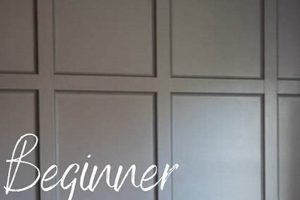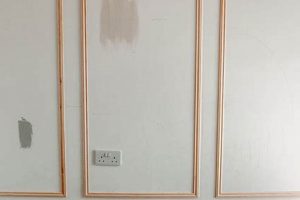A creative endeavor involving the manipulation of a specific gypsum-based material to produce decorative pieces intended for mounting on vertical surfaces, typically executed by individuals as a do-it-yourself project. For instance, a floral relief sculpted from the stated material and affixed to an interior wall exemplifies this type of artistic creation.
The practice offers an accessible avenue for personalization of interior spaces, allowing for bespoke designs that reflect individual aesthetic preferences and complement existing dcor. The materials relative low cost and ease of manipulation render it a popular choice for both novice and experienced crafters. Historically, similar materials have been employed in architectural ornamentation for centuries, demonstrating a lasting appeal in decorative arts.
The following sections will delve into the practical aspects of executing such projects, including material preparation, design considerations, and techniques for achieving professional-looking results. Attention will also be given to safety precautions and methods for ensuring the longevity and durability of the finished artwork.
Essential Guidelines for Working with Plaster of Paris in Wall Art Creation
This section provides crucial guidance for successfully executing plaster of paris wall art projects. Adherence to these recommendations will enhance the quality, durability, and safety of the final product.
Tip 1: Material Hydration: Precise water-to-plaster ratio is paramount. Deviations can compromise structural integrity. Consult manufacturer guidelines meticulously.
Tip 2: Workspace Preparation: Protect surrounding surfaces. Plaster adheres readily to unprotected materials. Employ drop cloths and appropriate barriers.
Tip 3: Mixing Technique: Add plaster gradually to water, avoiding clumping. Agitate gently but thoroughly. Overmixing introduces air, weakening the cured material.
Tip 4: Mold Release Agents: If using molds, apply a suitable release agent, such as petroleum jelly or silicone spray. Facilitates clean removal and prevents damage to the plaster and mold.
Tip 5: Layering Application: For complex designs, apply plaster in thin, successive layers. This reduces the risk of cracking and promotes even drying.
Tip 6: Reinforcement Integration: Consider incorporating reinforcement materials, such as burlap or wire mesh, for larger pieces. Increases resistance to stress and minimizes the likelihood of breakage.
Tip 7: Curing Environment: Allow plaster to cure fully in a controlled environment, away from direct sunlight and extreme temperature fluctuations. Rapid drying induces cracking.
Tip 8: Sealing and Finishing: Apply a sealant to protect the finished artwork from moisture and dust. Acrylic sealants are generally suitable. Consider painting or other decorative finishes to enhance visual appeal.
Careful application of these guidelines will yield professional results in plaster of paris wall art projects, extending the lifespan and maximizing the aesthetic impact of the finished artwork.
The following concluding remarks will summarize the key considerations for successful implementation of this decorative art form.
1. Material Quality
The inherent characteristics of the raw gypsum directly influence the outcome of “plaster of paris wall art diy” endeavors. Impurities or inconsistencies in the base material can manifest as surface imperfections, reduced structural integrity, and accelerated degradation of the finished artwork. For instance, gypsum containing excessive clay may exhibit increased shrinkage during the curing process, leading to cracking or warping. Similarly, the presence of coarse aggregates can result in a granular texture, detracting from the aesthetic appeal of intricately sculpted designs. Therefore, the selection of a high-purity gypsum is paramount to ensuring a professional finish and the longevity of the decorative piece.
Furthermore, the fineness of the gypsum powder affects its workability and ability to capture intricate details. A finely milled powder allows for smoother mixing and application, enabling the creation of more detailed and refined sculptural elements. Conversely, a coarsely ground powder may prove challenging to work with, resulting in a rougher texture and diminished ability to replicate fine features. Practical applications, such as casting delicate floral reliefs or geometric patterns, demand a material that can accurately reproduce the nuances of the design. The consistency and purity of the material directly translate to the quality of the artwork’s surface and overall aesthetic impact.
In summation, the link between gypsum quality and the success of “plaster of paris wall art diy” projects is undeniable. Utilizing high-grade materials mitigates the risk of defects, enhances workability, and promotes the creation of durable and visually appealing decorative pieces. Addressing the challenge of sourcing consistent and reliable gypsum stock is crucial for artisans seeking professional-grade results. The fundamental principle remains: the quality of the raw material dictates the quality of the final artwork.
2. Mixing Ratios
The proportion of gypsum powder to water is a critical determinant in the quality and workability of plaster for decorative wall art projects. Deviations from the optimal ratio can significantly compromise the structural integrity and aesthetic appeal of the finished piece.
- Optimal Consistency and Workability
An appropriate ratio yields a smooth, easily workable mixture. Insufficient water results in a thick, rapidly setting plaster, challenging precise detailing. Excess water weakens the plaster matrix, increasing the likelihood of cracking and reducing the artwork’s overall durability. For example, achieving fine floral details requires a slurry that flows readily into molds without premature setting.
- Curing Time and Strength
Precise measurements influence the rate at which the plaster hardens and its ultimate strength. An imbalance affects hydration, which compromises crystallization, and thus material density. If setting is rapid, air pockets can form from the escaping gas. If setting is too slow, the plaster remains weak and brittle. A sculpture needs to set up in a predictable, controlled way.
- Surface Finish and Detail Retention
Inappropriate mixing can lead to surface imperfections, such as pitting or chalkiness. Accurate ratios ensure uniform hydration, resulting in a smooth, receptive surface for painting or sealing. If the mix is sloppy from overhydration, the texture will be flawed, lacking the fineness of quality gypsum wall art.
- Adhesion Properties and Layering
When creating layered designs, consistent mixing across batches is crucial for ensuring proper adhesion. Variations in water content can lead to differential setting rates and weak bonding between layers. This is especially critical when creating multi-layered wall sculptures.
Ultimately, diligent adherence to recommended mixing ratios is non-negotiable when pursuing high-quality “plaster of paris wall art diy.” Accurate measurements prevent structural failures and promote a refined aesthetic. The skill in the slurry impacts the workability and lasting integrity of handcrafted artwork.
3. Design Complexity
The intricacies of design significantly influence the feasibility and execution of gypsum-based wall art, necessitating a tailored approach to material preparation and technique selection. Complex designs demand greater precision and control throughout the crafting process.
- Level of Detail
The presence of minute features or intricate patterns directly correlates with the skill level required and the time investment necessary. A simple geometric design, for instance, can be achieved with basic mold-making techniques, whereas a complex floral relief may necessitate advanced sculpting skills and the use of specialized tools. The more detailed the design, the higher the risk of defects or imperfections during the casting or carving process.
- Number of Components
Designs incorporating multiple separate elements, such as a collage of geometric shapes or a series of interconnected sculptural forms, introduce logistical challenges related to mold creation, component assembly, and overall structural integrity. Each individual piece must be cast or sculpted with precision to ensure seamless integration and a cohesive final product. Complex compositions may require the use of adhesives or reinforcing materials to maintain stability.
- Dimensionality and Depth
Wall art featuring significant three-dimensional elements or varying depths presents unique challenges in terms of mold design, material distribution, and structural support. Undercuts or protruding features may necessitate the use of multi-part molds or specialized release techniques. The weight and distribution of material must be carefully considered to prevent sagging or detachment from the wall.
- Surface Texture and Finish
Designs incorporating varied surface textures, such as smooth polished areas alongside rough, textured segments, require meticulous control over material application and finishing techniques. Achieving the desired contrast and visual interest may involve the use of specialized tools, such as texturing rollers or carving implements, as well as careful attention to sanding and polishing.
In summary, the level of “Design Complexity” directly impacts the resources, skills, and time required for successful completion of “plaster of paris wall art diy” projects. Simplification of designs or careful planning can mitigate potential challenges and enhance the likelihood of achieving satisfactory results. Therefore, careful design selection is necessary for the success of DIY plaster of paris wall art.
4. Curing Process
The hardening of gypsum-based art is known as the curing process, and it forms a vital step in the overall realization of the “plaster of paris wall art diy.” This phase involves the chemical transformation of the hydrated calcium sulfate, the primary component of the material, from a pliable state to a rigid structure. Variations in temperature, humidity, and airflow during the curing process directly influence the formation of crystalline structures within the material, thus dictating its ultimate strength and resistance to environmental factors. If curing happens too fast, it can lead to cracks. For example, a decorative panel left in direct sunlight will likely develop surface fractures due to uneven moisture evaporation, whereas one cured in a consistently cool and humid environment will exhibit greater structural integrity.
The rate and extent of hydration are closely related to the finished product. Slow, controlled evaporation of excess water allows for the formation of denser crystalline networks, improving the material’s resistance to impact and abrasion. Conversely, rapid drying can lead to porosity, weakening the structure and increasing its susceptibility to damage. In practical applications, this understanding is crucial for designing appropriate curing environments. Artisans may employ techniques such as covering the plaster with damp cloths or utilizing controlled-humidity chambers to regulate the curing process, ensuring consistent and predictable results. Consider the difference between an outdoor sculpture and a delicate indoor relief: each requires a carefully managed curing cycle tailored to its specific size, design, and intended environment.
Effective control of the curing process in “plaster of paris wall art diy” is, therefore, essential for realizing durable and visually appealing decorative pieces. Mastering the skill increases product integrity. Neglecting this phase introduces significant risks to the artwork’s longevity and aesthetic quality, underscoring the need for informed practices. The understanding of chemical transformations and application is key to the success of DIY projects.
5. Finishing Techniques
Finishing techniques are integral to achieving the desired aesthetic and ensuring the longevity of gypsum-based wall art. These methods encompass a range of processes applied after the curing phase, designed to enhance the material’s visual appeal, protect it from environmental damage, and refine its surface texture. In “plaster of paris wall art diy” projects, the selection and execution of appropriate finishing techniques directly influence the artwork’s overall impact and its ability to withstand the test of time. For instance, the application of a sealant protects the porous surface of plaster from moisture absorption, preventing the growth of mold and the deterioration of the material’s structural integrity. Without such protective measures, the artwork’s lifespan is significantly reduced, particularly in environments with high humidity. Similarly, the skillful application of paint or decorative coatings can transform a simple plaster casting into a visually striking piece that complements the surrounding dcor.
The practical application of finishing techniques extends beyond mere aesthetics. Sanding, for example, refines the surface of the plaster, removing imperfections and creating a smooth canvas for subsequent treatments. This process is particularly crucial for intricate designs where even minor irregularities can detract from the overall effect. Gilding, another common finishing technique, involves applying thin layers of metallic leaf to the plaster surface, adding a touch of elegance and sophistication. This technique requires careful preparation of the surface and precise application of the gilding material to ensure a flawless, uniform finish. Furthermore, faux finishing techniques, such as marbling or wood graining, can be employed to mimic the appearance of more expensive materials, adding depth and visual interest to the artwork.
In conclusion, the mastery of finishing techniques is paramount for successful “plaster of paris wall art diy” projects. These processes not only enhance the artwork’s visual appeal but also provide essential protection against environmental factors, ensuring its long-term durability. Overlooking or inadequately executing these techniques can lead to premature deterioration and a diminished aesthetic impact. Therefore, a thorough understanding of the various finishing options and their proper application is essential for achieving professional-quality results in plaster-based wall art creations. Understanding and proper selection of the finishing is a critical component of plaster of paris wall art.
6. Mounting Stability
The secure affixation of gypsum-based wall art directly impacts the longevity and aesthetic presentation of such decorative pieces. Inadequate mounting compromises not only the artwork’s visual appeal but also poses potential safety hazards. Stability, therefore, is a paramount consideration within “plaster of paris wall art diy” projects.
- Weight Distribution Considerations
The inherent density of gypsum renders weight distribution a critical factor. Improperly balanced artwork places undue stress on mounting hardware and the supporting wall surface. For instance, a large, asymmetrical piece requires multiple anchor points strategically positioned to evenly distribute the load. Failure to account for weight distribution increases the risk of detachment and potential damage to the artwork and surrounding area. The amount of reinforcement also matters. More support or weight means it is less likely to fall.
- Appropriate Hardware Selection
Matching the mounting hardware to the weight and dimensions of the artwork is crucial. Lightweight pieces may be adequately supported by simple picture hooks, whereas heavier pieces necessitate robust anchors capable of bearing significant loads. The selection should consider the wall material; drywall requires specialized anchors that expand to distribute the weight, while masonry walls demand heavy-duty screws and anchors. Selecting improper hardware can cause long-term damage.
- Wall Surface Integrity
The condition of the wall surface directly impacts the security of the mounting. Weak or damaged walls, such as those with crumbling plaster or deteriorated drywall, provide insufficient support for heavy artwork. Prior to mounting, the wall surface should be inspected and repaired as necessary. Reinforcement techniques, such as adding a backing board or structural support, may be required to ensure adequate stability. Ignoring wall surface integrity can also lead to instability. Poor mounting can be damaging to the integrity of your art wall.
- Environmental Factors Influence
Changes in temperature and humidity can affect both the artwork and the mounting hardware. Gypsum is susceptible to expansion and contraction, potentially loosening the connection between the artwork and the wall. Similarly, metal hardware may corrode over time, compromising its strength. Choosing hardware and mounting locations that minimize exposure to extreme environmental conditions is essential for long-term stability. Thus, it is vital to choose the best hardware.
In conclusion, mounting stability represents an indispensable facet of successful gypsum-based wall art creation. Thorough consideration of weight distribution, hardware selection, wall surface integrity, and environmental influences ensures the secure and enduring display of these decorative objects. Neglecting these factors can result in aesthetic compromise and potential safety risks, underscoring the importance of meticulous planning and execution in “plaster of paris wall art diy” endeavors.
Frequently Asked Questions
The following addresses common inquiries concerning the creation of decorative wall art utilizing gypsum-based compounds. These questions aim to provide clarity and address potential challenges encountered during the project execution.
Question 1: What is the optimal method for preventing cracks from forming in larger gypsum wall art pieces?
The incorporation of reinforcement materials, such as burlap or fiberglass mesh, within the plaster matrix significantly enhances tensile strength and mitigates the likelihood of cracking. Furthermore, maintaining a controlled curing environment, characterized by gradual drying and consistent temperature, minimizes stress within the material.
Question 2: How does one ensure proper adhesion when layering gypsum on gypsum in multi-layered wall art designs?
Surface preparation is paramount. Scoring or lightly roughening the existing layer creates a mechanical bond for subsequent layers. Additionally, dampening the existing surface prior to applying fresh plaster enhances adhesion. The use of a bonding agent, such as diluted PVA glue, can further improve the bond strength.
Question 3: What is the recommended sealant for protecting gypsum wall art intended for display in humid environments?
Acrylic-based sealants are generally suitable for providing a moisture-resistant barrier. However, for environments with particularly high humidity, epoxy-based sealants offer superior protection. Multiple coats are recommended, ensuring complete coverage of the plaster surface.
Question 4: What are the potential health risks associated with working with gypsum powder, and what precautions should be taken?
Inhalation of gypsum powder can cause respiratory irritation. It is advisable to work in a well-ventilated area and to wear a dust mask or respirator to minimize exposure. Prolonged skin contact may also cause irritation; wearing gloves is recommended.
Question 5: How does one effectively remove air bubbles from gypsum mixtures to achieve a smooth, defect-free surface?
Vigorous mixing introduces air. Gentle tapping or vibrating the mold or casting after pouring the plaster allows trapped air bubbles to rise to the surface and dissipate. The use of a vacuum chamber can further enhance air removal for critical applications.
Question 6: What is the best method for repairing minor chips or cracks in finished gypsum wall art?
A patching compound formulated specifically for gypsum is recommended. The damaged area should be cleaned and lightly dampened before applying the compound. After the patch has dried, it can be sanded smooth and painted to match the surrounding surface.
These answers provide guidance for overcoming common challenges associated with gypsum-based wall art. Adherence to these recommendations promotes project success and ensures the longevity of the finished artwork.
The subsequent section will provide a glossary of technical terms commonly used in the context of gypsum-based wall art creation.
Conclusion
The preceding exploration of “plaster of paris wall art diy” has illuminated the multifaceted nature of this creative endeavor. Successful execution requires meticulous attention to material selection, precise mixing ratios, nuanced design considerations, controlled curing processes, refined finishing techniques, and robust mounting strategies. Each element contributes significantly to the aesthetic quality and structural integrity of the finished artwork.
The pursuit of this art form offers an accessible means of personalizing interior spaces and expressing individual creativity. By embracing the principles and techniques outlined herein, artisans can transform raw materials into enduring works of art that enhance the visual environment. Continued experimentation and refinement of skills promise to expand the possibilities within “plaster of paris wall art diy,” contributing to its ongoing evolution as a recognized form of decorative expression.







